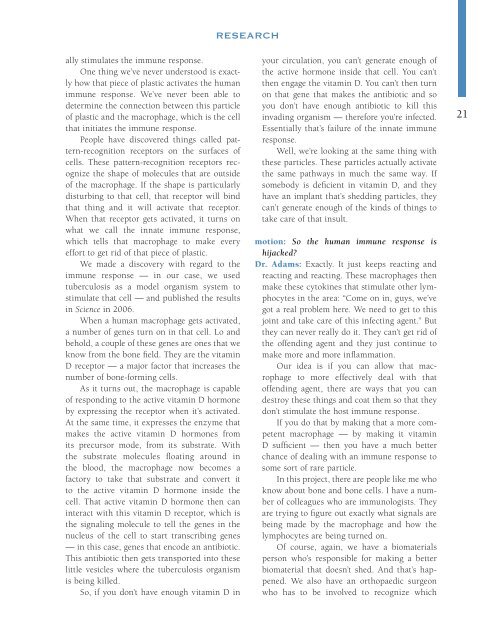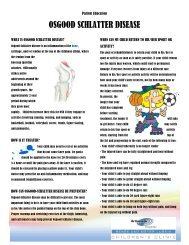“It's A Bargain” Thrift Shop - Orthopaedic Hospital
“It's A Bargain” Thrift Shop - Orthopaedic Hospital
“It's A Bargain” Thrift Shop - Orthopaedic Hospital
You also want an ePaper? Increase the reach of your titles
YUMPU automatically turns print PDFs into web optimized ePapers that Google loves.
ally stimulates the immune response.<br />
One thing we’ve never understood is exactly<br />
how that piece of plastic activates the human<br />
immune response. We’ve never been able to<br />
determine the connection between this particle<br />
of plastic and the macrophage, which is the cell<br />
that initiates the immune response.<br />
People have discovered things called pattern-recognition<br />
receptors on the surfaces of<br />
cells. These pattern-recognition receptors recognize<br />
the shape of molecules that are outside<br />
of the macrophage. If the shape is particularly<br />
disturbing to that cell, that receptor will bind<br />
that thing and it will activate that receptor.<br />
When that receptor gets activated, it turns on<br />
what we call the innate immune response,<br />
which tells that macrophage to make every<br />
effort to get rid of that piece of plastic.<br />
We made a discovery with regard to the<br />
immune response — in our case, we used<br />
tuberculosis as a model organism system to<br />
stimulate that cell — and published the results<br />
in Science in 2006.<br />
When a human macrophage gets activated,<br />
a number of genes turn on in that cell. Lo and<br />
behold, a couple of these genes are ones that we<br />
know from the bone field. They are the vitamin<br />
D receptor — a major factor that increases the<br />
number of bone-forming cells.<br />
As it turns out, the macrophage is capable<br />
of responding to the active vitamin D hormone<br />
by expressing the receptor when it’s activated.<br />
At the same time, it expresses the enzyme that<br />
makes the active vitamin D hormones from<br />
its precursor mode, from its substrate. With<br />
the substrate molecules floating around in<br />
the blood, the macrophage now becomes a<br />
factory to take that substrate and convert it<br />
to the active vitamin D hormone inside the<br />
cell. That active vitamin D hormone then can<br />
interact with this vitamin D receptor, which is<br />
the signaling molecule to tell the genes in the<br />
nucleus of the cell to start transcribing genes<br />
— in this case, genes that encode an antibiotic.<br />
This antibiotic then gets transported into these<br />
little vesicles where the tuberculosis organism<br />
is being killed.<br />
So, if you don’t have enough vitamin D in<br />
research<br />
your circulation, you can’t generate enough of<br />
the active hormone inside that cell. You can’t<br />
then engage the vitamin D. You can’t then turn<br />
on that gene that makes the antibiotic and so<br />
you don’t have enough antibiotic to kill this<br />
invading organism — therefore you’re infected.<br />
Essentially that’s failure of the innate immune<br />
response.<br />
Well, we’re looking at the same thing with<br />
these particles. These particles actually activate<br />
the same pathways in much the same way. If<br />
somebody is deficient in vitamin D, and they<br />
have an implant that’s shedding particles, they<br />
can’t generate enough of the kinds of things to<br />
take care of that insult.<br />
motion: So the human immune response is<br />
hijacked?<br />
Dr. Adams: Exactly. It just keeps reacting and<br />
reacting and reacting. These macrophages then<br />
make these cytokines that stimulate other lymphocytes<br />
in the area: “Come on in, guys, we’ve<br />
got a real problem here. We need to get to this<br />
joint and take care of this infecting agent.” But<br />
they can never really do it. They can’t get rid of<br />
the offending agent and they just continue to<br />
make more and more inflammation.<br />
Our idea is if you can allow that macrophage<br />
to more effectively deal with that<br />
offending agent, there are ways that you can<br />
destroy these things and coat them so that they<br />
don’t stimulate the host immune response.<br />
If you do that by making that a more competent<br />
macrophage — by making it vitamin<br />
D sufficient — then you have a much better<br />
chance of dealing with an immune response to<br />
some sort of rare particle.<br />
In this project, there are people like me who<br />
know about bone and bone cells. I have a number<br />
of colleagues who are immunologists. They<br />
are trying to figure out exactly what signals are<br />
being made by the macrophage and how the<br />
lymphocytes are being turned on.<br />
Of course, again, we have a biomaterials<br />
person who’s responsible for making a better<br />
biomaterial that doesn’t shed. And that’s happened.<br />
We also have an orthopaedic surgeon<br />
who has to be involved to recognize which<br />
21



